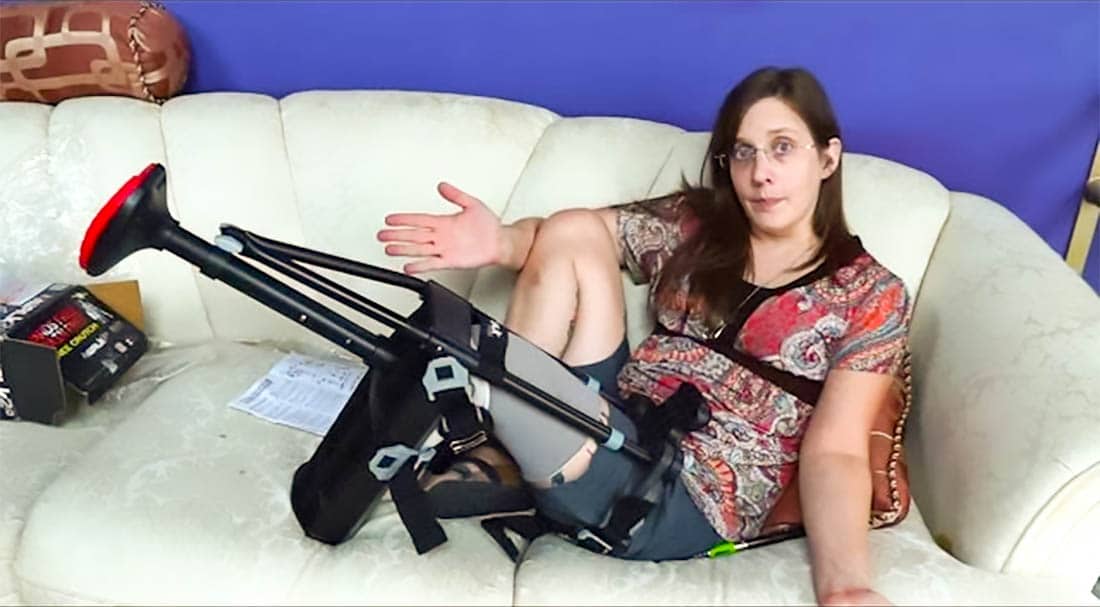
FAQ About the iWALK Crutch
For answers to all your frequently asked questions visit the iWALKFree Help Center – an extensive knowledgebase of iWALK crutch information and self-help solutions.
Most people with average strength and balance can use the iWALK crutch, but not everyone. The best way to find out if iWALK is right for you is to take our online test, “Can I Use the iWALK”. It will take 2-3 minutes – a worthy investment of time. Or, you can visit our page dedicated to this topic.
Physical ability varies from person to person, especially as we age, so setting age limits for using the iWALK crutch isn’t entirely accurate. Instead, we use ABILITY LIMITS, which are relevant no matter what your age is. Let’s start with this:
Before your injury, could you go up and down a flight of stairs at normal walking speed, without using the handrail? If yes, you likely have the physical capabilities to use the iWALK, but there’s more to it. Please click on the button below to learn more.
Possibly. We wish we could give you a better answer, however, with the constantly changing climate of health insurance, there is no simple answer. Coverage for traditional crutch alternatives depends on your insurance carrier, your physician, where you live, and other factors over which we have no control. Check with your physician and insurance company to find out if the device is covered and what percentage or amount they will pay. You can also take a more proactive approach. Administering your own claim is not difficult, and we have had many customers who choose this route and are successful. To make things easier, we’ve provided step-by-step instructions which you can find by clicking here. Typically iWALKFree will be classified under the DME (Durable Medical Equipment) portion of your insurance policy, however, there are many exceptions. When making inquiries to your physician or insurance company, you will want to provide them with our product code, which is HCPCS E0118-NU.
For more information, please visit the Insurance page of our website, or check with your local retailer or distributor.
Yes. iWALK is FSA & HSA eligible. We accept both FSA and HSA cards at checkout.
You have many choices when it comes to buying the iWALK crutch. If you are in USA or Canada, you can get it directly from us, via our online shopping cart. We also have a large network of durable medical equipment retailers that you can choose from. Find a local dealer here. There are also several online options which you can easily find doing a Google search for iWALK. For purchases outside of USA or Canada, please check our International Distributor Listing.
Most likely the answer is yes. It is very common for people to wear a boot or cast when using the iWALK, however, there are some situations where there can be complications. We’ve created a resource page dedicated specifically for this topic, so if you are using a cast or boot, please review all the information on our Boots and Casts page.
No. There is a common misconception that you are kneeling on your knee (maybe that’s why the word is “knee-l”) when using iWALK, but you don’t. When you use the iWALK, only your shin comes in contact with the knee platform (perhaps we should have called it the shin platform?) When the knee is bent 90 degrees, the patellar region is not in contact with the platform and thus does not bear any direct weight when using the iWALK.
In rare instances, the iWALK can cause localized soreness in the tibial tuberocity, which is the area of the shin directly below the knee.
For most people, the transition from the knee to the shin (tibia) is fairly straight, but some people have a pronounced bump. In extreme cases, the size of this protrusion is more than the standard foam padding on the iWALK can support, which can result in a localized painful “hot spot”.
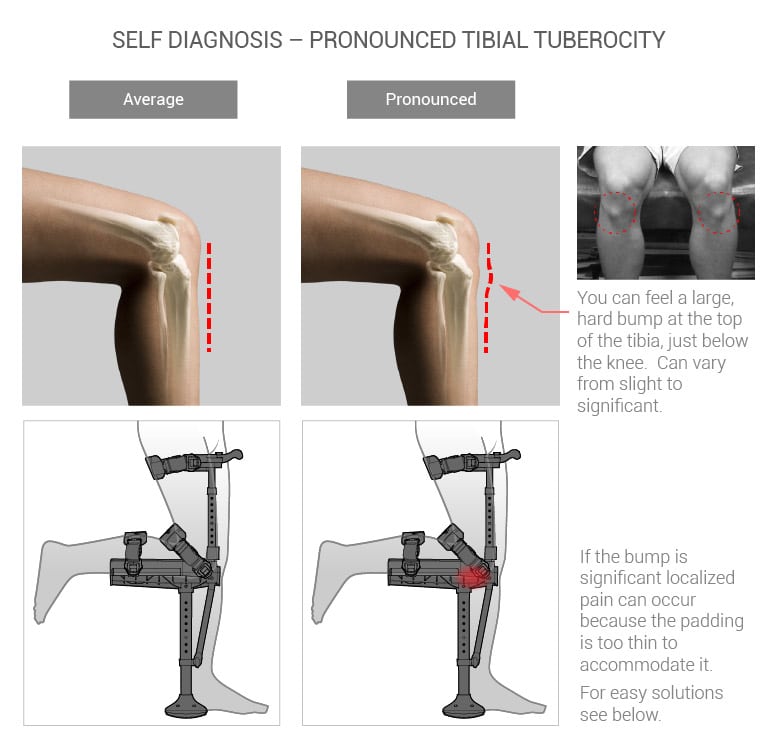
Fortunately, there’s an easy solution – just augment the existing foam near the front of the crutch to accommodate the condition. You can purchase a replacement pad from us and simply install it on top of the existing pad, or you can also try some other readily available remedies, such as a folded hand towel, inexpensive gardening knee pads found at home improvement stores, etc. To gain a better understanding of the situation and the solution, see our diagrams above.
We could simply use a thicker pad to accommodate everyone, but we don’t – and here’s why. The connection between the leg and the crutch is crucial for feel and control. Basically, you want the iWALK crutch to be an integral part of your leg. Having no padding would be the ideal, but it would be too uncomfortable. So we intentionally use the minimum amount of padding to provide the best compromise between comfort and control.
Yes. Navigating stairs on conventional crutches is dangerous and strenuous, but taking stairs is one thing that you can do with your iWALK crutch that you can’t do with a knee scooter or conventional crutches.
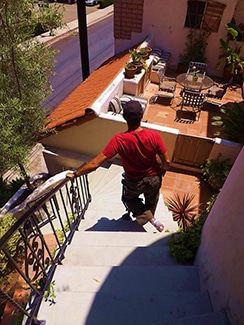
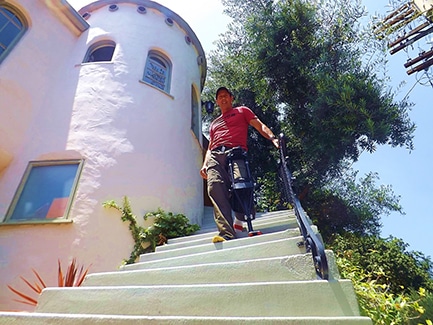
NAVIGATING STAIRS ON THE IWALK
Always use the handrail when using your iWALK crutch on stairs. If two handrails are available, use both.
Going up – Always go one step at a time. Lead with your good foot, then bring your crutch foot up to the same step as your good leg so that you’re now standing on that step with iWALK foot beside your good foot. Proceed to the next step, leading with your good leg again, followed by your iWALK leg. Repeat the process.
Going down – Most people prefer to go downstairs backwards (facing up). It sounds scary, but it’s actually quite easy. Always go one step at a time. Holding the handrail(s), Lead with your crutch foot, then follow with your good foot, placing it on the step beside your crutch foot. Repeat the process.
Going down alternate – While not recommended, some people prefer to descend stairs facing forward. In order for this to work, you must turn slightly sideways rather than face straight down, such that your injured lower leg is outwardly rotated and does not come into contact with the uphill step while descending. Start with your crutch foot, followed by your good foot, one step at a time.
The iWALK crutch is extremely durable, and overqualified to meet the time required to heal from most lower limb injuries (3-10 weeks). For long term users, such as below knee amputees, those with CRPS, or other long term or permanent non-weight bearing injuries, be aware that the iWALK will eventually wear out with continuous use. Much like an athletic shoe, how long it lasts depends on the amount and conditions of use.
Yes! But if the height difference is more than 1/2 inch, you’ll probably want to adjust the height of the lower crutch. Luckily we’ve thought of this, so it’s quick and easy to make height adjustments.
Yes. The special padding used on your iWALK is hypoallergenic and FDA and CE-approved to come in contact with your skin. In some instances, people with sensitive skin may experience minor chafe from the strap that goes behind the knee. In these cases, you can augment the padding using a simple home fix such as wrapping a hand towel around the strap or you can forego short pants for long pants.
Yes, but you’ll need ample space in front of your chair for the beam below your knee to extend. If this is an issue, we’ve designed iWALK crutch to be easy and quick to put on and take off.

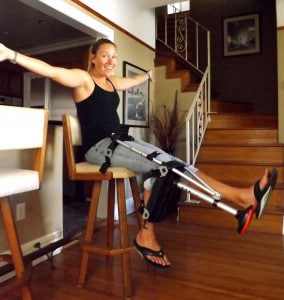
Most often the answer is yes, however, in some instances you cannot. The location and the severity of the fracture plays an important part in determining if the iWALK crutch is right for you. If in doubt, check with your physician.
Answer: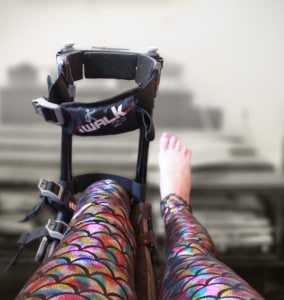 Absolutely- in fact, the iWALK crutch is an everyday item for many BK amputees who use it in common situations when they don’t want to don their prosthetic leg. Examples are showering, short trips, at the gym, beach etc. iWALK crutch is commonly used as a prosthetic training device for new amputees who are learning to walk on a prosthetic or for those who cannot yet tolerate a prosthetic limb. Also, if your prosthetic limb isn’t available, for example, if it’s getting repaired, the iWALK crutch is your best substitute.
Absolutely- in fact, the iWALK crutch is an everyday item for many BK amputees who use it in common situations when they don’t want to don their prosthetic leg. Examples are showering, short trips, at the gym, beach etc. iWALK crutch is commonly used as a prosthetic training device for new amputees who are learning to walk on a prosthetic or for those who cannot yet tolerate a prosthetic limb. Also, if your prosthetic limb isn’t available, for example, if it’s getting repaired, the iWALK crutch is your best substitute.
A commonly overlooked feature of the iWALK crutch is that the mounts for the calf strap are free to slide forward and back on the “rails” which are built in to the side of the knee platform. This was done so that the user could position the strap in different locations to accommodate different conditions, casts, boots, etc. For amputees, this feature is key as it allows forward placement of the strap to accommodate residual limbs as short as four inches.
For more information about BKA use of iWALK crutches, see our dedicated BKA page here.
To see testimonials from BKA’s using the iWALK, click here.
The tread used on the iWALK is produced for us by Vibram. For those not familiar, Vibram is one of the leading shoe and boot outsole manufacturers in the world. Their experience in rubber compounding and manufacturing is first-class. iWALK teamed up with Vibram to create a tread that provides excellent dry and wet traction combined with durability. It provides traction on par with the best athletic shoes.
That said, any hard, wet surface can be slippery, and while the traction of the Vibram is impressive, under the right circumstances anything can slip. So always use caution and common sense when navigating slippery surfaces.
28″ at the very top of your thigh is the largest that we would recommend for a couple of reasons. First, and most importantly, going beyond the 28″ maximum can make it more difficult to tighten the straps as much as is necessary for proper function. Second, the quick-release buckles on the straps might not function optimally because you may not be able to loosen the straps enough to allow easy engagement and disengagement. We have seen people use the iWALK crutch with up to a 29″ thigh, but you need to be aware and accepting of the possible functional compromises.
We’ve used industry standard studies to determine the sizing range for the iWALK crutch. That said, humans come in all sizes and shapes, so there will always be rare instances where the iWALK won’t fit people even though they fall inside our size range.
Leg length is what matters for sizing the iWALK crutch. But nobody knows their leg lengths, so we use overall height as a starting point. The industry studies we use cover 95% of the human population, so what that means is that at the far extents of our size range (4’10” and 6’6”), there’s a 95% chance the iWALK will fit. As you move further from the minimum/maximum range, the greater the chance that the iWALK will fit. In fact, we know that the iWALK will fit people that are shorter or taller than our minimum/maximum requirements.
We provide a leg length chart that details the requirements for both upper and lower leg length. This is the only way to be 100% certain that the iWALK crutch will fit.
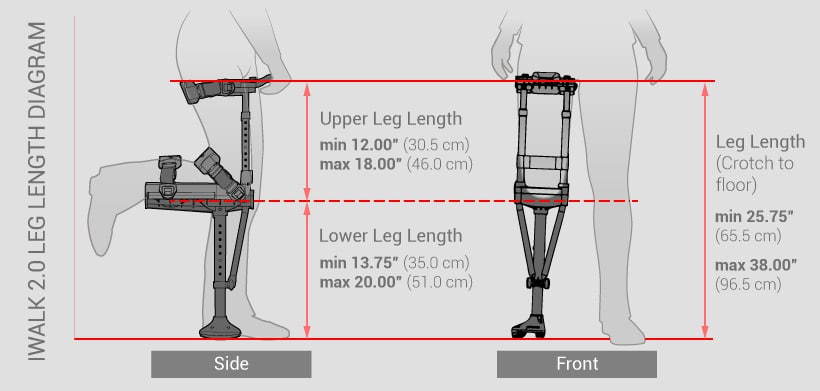
For more detailed information about sizing click here.
For most people, pain or fatigue in the unaffected leg is due to two possible issues:
- Incorrect adjustment. Proper fit is everything. The crutch needs to become an extension of your leg, which means height (both above the knee platform and below it), vertical alignment and proper strap tension (tight!!!) need to be correct. We show you how to achieve this in our instruction video, shown here.
- Another common issue is not fully committing your weight to the crutch. This typically happens during learning, and goes away when you gain proficiency. In normal human gait, 40% of the time you are putting all your weight on only one foot. This happens when you ‘toe-off’ with your back foot and bring it back to the front. At this point, you have all your weight committed to the other foot. When using the crutch, it’s normal for beginners to not commit all their weight, and they rush to get the good foot back on the ground. This over-recruits the good leg, which can result in unnatural gait adaptations, which, in turn, recruits muscles that are normally dormant or lightly utilized during normal gait. This can cause fatigue or pain.
The iWALK crutch works best if you treat it like it’s a normal leg. The less you try to adapt, the better it works. You need to trust it. With time and increased proficiency, your gait will become more normal, and the fatigue and/or pain will diminish.
If this does not solve your problem, then contact us so we can troubleshoot your specific case.
Diabetic foot ulcers are often accompanied by Neuropathy, or damage to the peripheral nerves of the foot or feet. This can cause numbness and reduced proprioception, making basic balance difficult. If you have difficulty balancing on your non-affected limb, then you probably will not have success with the iWALK crutch. To find out, try this – If, in addition to the standard qualifications listed here, you can stand unassisted on only your unaffected foot for 30 seconds, without assistance, then you’re likely capable of using the iWALK crutch. But because of the special circumstances surrounding diabetic induced Neuropathy, we recommend that you check with your physician or therapist prior to using the iWALK. If your diabetic condition resulted in lower leg amputation, see the additional guidelines here.


